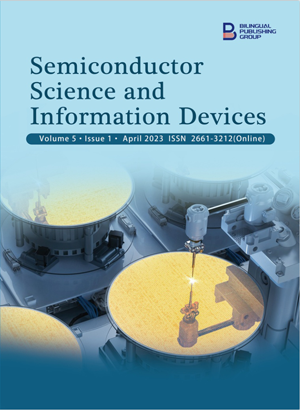Sub-nano Layers of Li, Be, and Al on the Si(100) Surface: Electronic Structure and Silicide Formation
DOI:
https://doi.org/10.30564/ssid.v5i1.5982Abstract
Within the framework of the density functional theory and the pseudopotential method, the electronic structure calculations of the “metal-Si(100)” systems with Li, Be and Al as metal coverings of one to four monolayers (ML) thickness, were carried out. Calculations showed that band gaps of 1.02 eV, 0.98 eV, and 0.5 eV, respectively, appear in the densities of electronic states when the thickness of Li, Be and Al coverings is one ML. These gaps disappear with increasing thickness of the metal layers: first in the Li-Si system (for two ML), then in the Al-Si system (for three ML), and then in the Be-Si system (for four ML). This behavior of the band gap can be explained by the passivation of the substrate surface states and the peculiarities of the electronic structure of the adsorbed metals. In common the results can be interpreted as describing the possibility of the formation of a two-dimensional silicide with semiconducting properties in Li-Si(100), Be-Si(100), and Al-Si(100) systems.
Keywords:
Kohn-Sham method; Pseudopotentials; Si(100) surface; Sub-nano metal layers; Density of states; Two-dimensional silicides; Semiconducting propertiesReferences
[1] Kotlyar, V.G., Saranin, A.A., Zotov, A.V., et al., 2002. High-temperature interaction of Al with Si(100) surface at low Al coverages. Surface Science. 506(1-2), 80-86. DOI: https://doi.org/10.1016/S0039-6028(01)01768-X
[2] Cocoletzi, G.H., Takeuchi, N., 2002. First principles total energy calculations of the Al induced Si (0 0 1)-(3×4) reconstruction. Surface Science. 504, 101-107. DOI: https://doi.org/10.1016/S0039-6028(01)01915-X
[3] Northrup, J.E., 1984. Si(111)√3×√3-Al: An adatom-induced reconstruction. Physical Review Letters. 53(7), 683-686. DOI: https://doi.org/10.1103/PhysRevLett.53.683
[4] Ko, Y.J., Chang, K.J., Yi, J.Y., 1997. Atomic and electronic structure of Li-adsorbed Si(100) surfaces. Physical Review B. 56(15), 9575. DOI: https://doi.org/10.1103/PhysRevB.56.9575
[5] Rysbaev, A.S., Normurodov, M.T., Khujaniyozov, J.B., et al., 2021. On the formation of silicide films of metals (Li, Cs, Rb, and Ba) during ion implantation in Si and subsequent thermal annealing. Journal of Surface Investigation: X-ray, Synchrotron and Neutron Techniques. 15(3), 607-610.DOI: https://doi.org/10.1134/S10274510210303
[6] Hite, D.A., Tang, S.J., Sprunger, P.T., 2003. Reactive epitaxy of beryllium on Si (1 1 1)-(7×7). Chemical Physics Letters. 367(1-2), 129-135. DOI: https://doi.org/10.1016/S0009-2614(02)01637-8
[7] Saranin, A.A., Zotov, A.V., Kotlyar, V.G., et al., 2004. Ordered arrays of Be-encapsulated Si nanotubes on Si (111) surface. Nano Letters. 4(8), 1469-1473.
[8] Gordeev, I., Kolotova, L., Starikov, S., 2022. Formation of metastable aluminum silicide as intermediate stage of Al-Si alloy crystallization. Scripta Materialia. 210, 114481. DOI: https://doi.org/10.1016/j.scriptamat.2021.114481
[9] Terekhov, V.A., Usoltseva, D.S., Serbin, O.V., et al., 2018. Possibility of the metastable Al3Si phase formation in composite Al-Si films obtained by ion-beam and magnetron sputtering. Condensed Matter and Interphases. 20(1), 135-147. DOI: https://doi.org/10.17308/kcmf.2018.20/485
[10] Endo, K., Arima, K., Kataoka, T., et al., 1998. STM/STS and the first principles calculations on Al/Si (001) 2×1. Applied Physics A. 66, S145-S148. DOI: https://doi.org/10.1007/s003390051118
[11] Clark, S.J., Al-Allak, H.M., Brand, S., et al., 1998. Structure and electronic properties of FeSi2. Physical Review B. 58(16), 10389. DOI: https://doi.org/10.1103/PhysRevB.58.10389
[12] Kohn, W., Sham, L.J., 1965. Self-consistent equations including exchange and correlation effects. Physical Review. 140(4A), A1133. DOI: https://doi.org/10.1103/PhysRev.140.A1133
[13] Hohenberg, P., Kohn, W., 1964. Inhomogeneous electron gas. Physical Review. 136(3B), B864. DOI: https://doi.org/10.1103/PhysRev.136.B864
[14] Fuchs, M., Scheffler, M., 1999. Ab initio pseu dopotentials for electronic structure calculations of poly-atomic systems using density-functional theory. Computer Physics Communications. 119(1), 67-98. DOI: http://dx.doi.org/10.1016/S0010-4655(98)00201-X
[15] Bockstedte, M., Kley, A., Neugebauer, J., et al., 1997. Density-functional theory calculations for poly-atomic systems: Electronic structure, static and elastic properties and ab initio molecular dynamics. Computer Physics Communications. 107(1-3), 187-222. DOI: http://dx.doi.org/10.1016/S0010-4655(97)00117-3
[16] Ceperley, D.M., Alder, B.J., 1980. Ground state of the electron gas by a stochastic method. Physical Review Letters. 45(7), 566. DOI: https://doi.org/10.1103/PhysRevLett.45.566
[17] Perdew, J.P., Zunger, A., 1981. Self-interaction correction to density-functional approximations for many-electron systems. Physical Review B. 23(10), 5048. DOI: https://doi.org/10.1103/PhysRevB.23.5048
[18] Gavioli, L., Betti, M.G., Cricenti, A., et al., 1995. Surface electronic structure at Si (100)-(2x1). Journal of Electron Spectroscopy and Related Phenomena. 76, 541-545.
[19] Hata, K., Shibata, Y., Shigekawa, H., 2001. Fine electronic structure of the buckled dimers of Si(100) elucidated by atomically resolved scanning tunneling spectroscopy and bias-dependent imaging. Physical Review B. 64(23), 235310. DOI: https://doi.org/10.1103/PhysRevB.64.235310
[20] Fritsch, J., Pavone, P., 1995. Ab initio calculation of the structure, electronic states, and the phonon dispersion of the Si(100) surface. Surface Science. 344(1-2), 159-173. DOI: https://doi.org/10.1016/0039-6028(95)00802-0
Downloads
How to Cite
Issue
Article Type
License
Copyright © 2023 Victor Zavodinsky, Olga Gorkusha

This is an open access article under the Creative Commons Attribution-NonCommercial 4.0 International (CC BY-NC 4.0) License.




 Aims and Scope
Aims and Scope Victor Zavodinsky
Victor Zavodinsky






